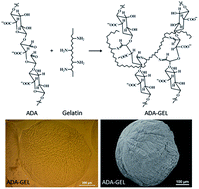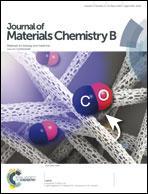Fabrication of alginate–gelatin crosslinked hydrogel microcapsules and evaluation of the microstructure and physico-chemical properties
Abstract
Microencapsulation of cells by using biodegradable hydrogels offers numerous attractive features for a variety of biomedical applications including tissue engineering. This study highlights the fabrication of microcapsules from an alginate–gelatin crosslinked hydrogel (ADA–GEL) and presents the evaluation of the physico-chemical properties of the new microcapsules which are relevant for designing suitable microcapsules for tissue engineering. Alginate di-aldehyde (ADA) was synthesized by periodate oxidation of alginate which facilitates crosslinking with gelatin through Schiff's base formation between the free amino groups of gelatin and the available aldehyde groups of ADA. Formation of Schiff's base in ADA–GEL and aldehyde groups in ADA was confirmed by FTIR and NMR spectroscopy, respectively. Thermal degradation behavior of films and microcapsules fabricated from alginate, ADA and ADA–GEL was dependent on the hydrogel composition. The gelation time of ADA–GEL was found to decrease with increasing gelatin content. The swelling ratio of ADA–GEL microcapsules of all compositions was significantly decreased, whereas the degradability was found to increase with the increase of gelatin ratio. The surface morphology of the ADA–GEL microcapsules was totally different from that of alginate and ADA microcapsules, observed by SEM. Two different buffer solutions (with and without calcium salt) have an influence on the stability of microcapsules which had a significant effect on the gelatin release profile of ADA–GEL microcapsules in these two buffer solutions.


 Please wait while we load your content...
Please wait while we load your content...